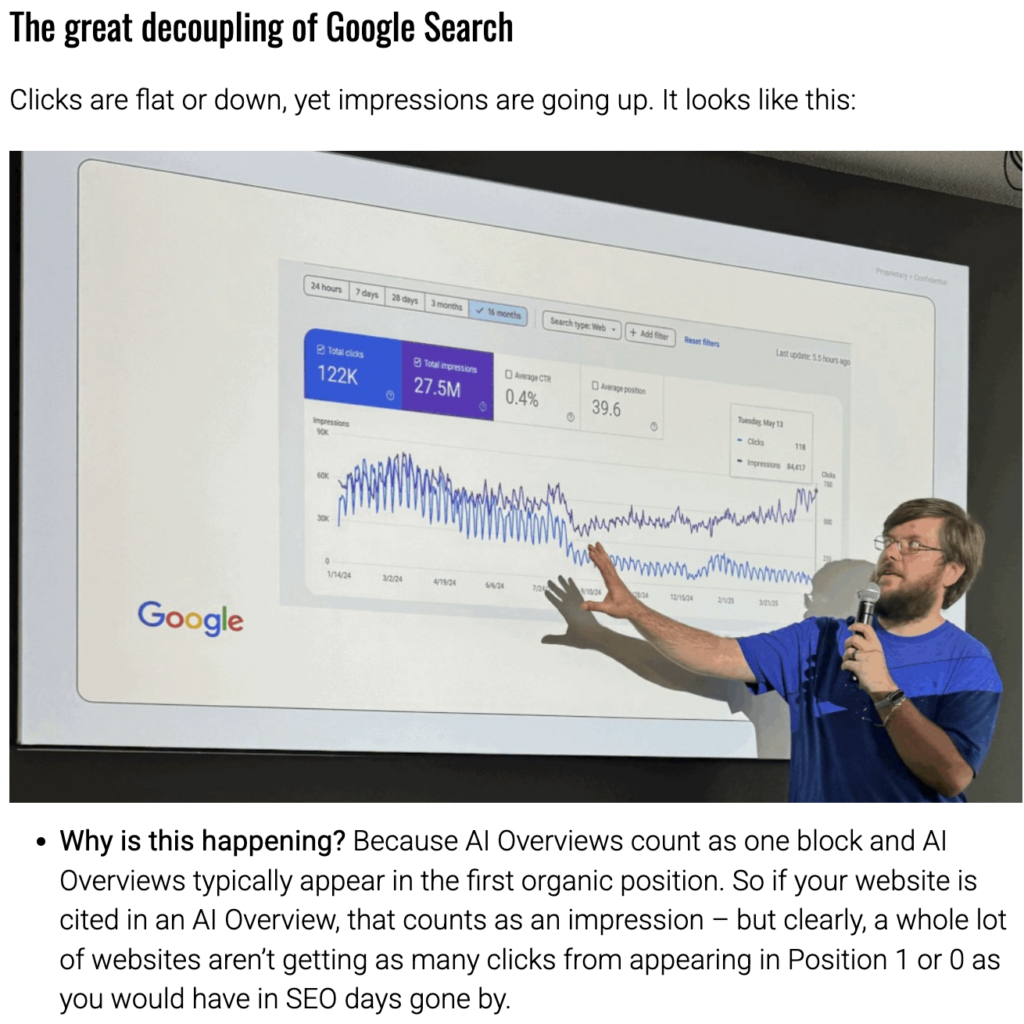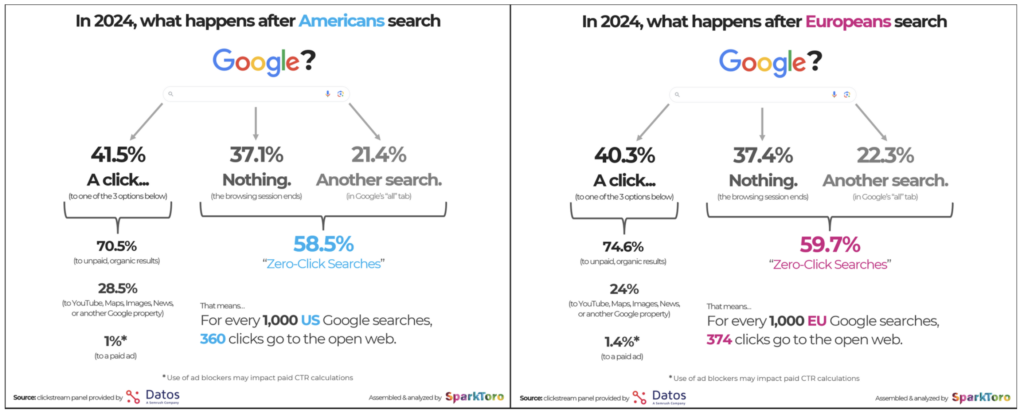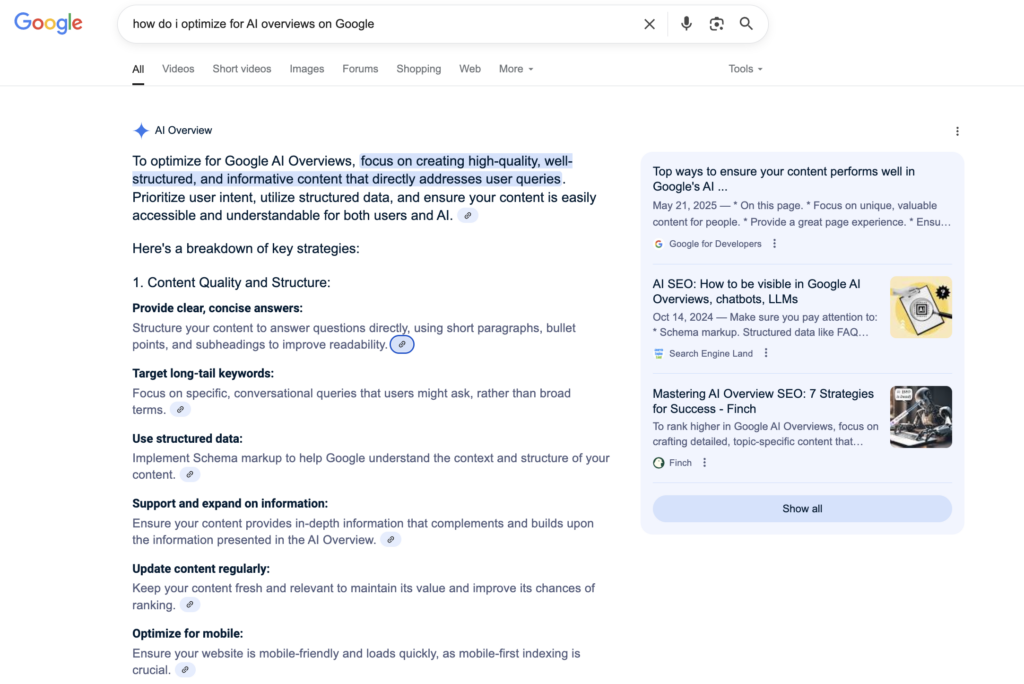Generative Engine Optimization (GEO) is the inevitable existential conundrum the SEO industry must confront.
Did you ever stop to think about where the phrase “the writing on the wall” comes from?
This ubiquitous description of an impending negative event originates from the Book of Daniel in The Bible.
If you’re not familiar with the story of King Belshazzar of Babylon, it goes something like this…

King Belshazzar was hosting a glorious feast to show defiance against the medo-persian forces laying siege to Babylon. In his arrogance and entitlement, he ordered several sacred vessels taken from the temple in Jerusalem be used for drinking, which was effectively a gesture of contempt for the god of the Jews. As King Belshazzar and a thousand of his lords drank and celebrated their invincibility, a mysterious hand suddenly appeared and wrote the following on a wall in the palace for all to see:
“Mene, Mene, Tekel, Parsin”
Daniel (previously a captive of King Nebuchadnezzar) who was recognized as having the ability to interpret divine messages, was summoned to read the writing on the wall and clarify its meaning. A much longer story short – Daniel informed King Belshazzar that the “writing on the wall” was a direct indication from a divine power that his reign was imminent to end. And sure enough – it did.

Being able to read the “writing on the wall” is very different from simply seeing it. And just as Daniel interpreted the meaning of the writing (which ultimately proved accurate), so too must we interpret those prognostic messages which confront us, personally and professionally, in whatever mysterious form they appear.
And that is exactly what I feel compelled to do, now that I keep finding the phrase GEO (Generative Engine Optimization) making its way into the mainstream marketing discussions of 2025.

(Source: SE Land)
Danny Goodwin of Search Engine Land wrote a rather salient article last week that had a significantly introspective impact for any long time practitioner of SEO. The article solidified a poignant consideration which has confronted me for a few months more than a year: organic traffic is vanishing.
And quickly.
Was it inevitable that Google’s unending quest to become the Star Trek computer would lead to a generative search experience which surfaced information without the need to visit websites?
Cloudflare CEO Matthew Prince argued, recently, that Google’s shift to AI overviews intrinsically challenges the nature of the web (as we know it):
“AI is going to fundamentally change the business model of the web. The business model of the web for the last 15 years has been search… search drives everything that happens online.”
Conveniently enough, it seems, Google executives are concurrently concerned that AI (even their own product, Gemini) is threatening their legacy business model (in the context of search). In a trial document from The Plaintiff States vs Google LLC (one of Google’s ongoing monopoly trials), Google executives appear to factor strategies to offset search traffic’s anything but ephemeral decline:
“We have 3 options: (1) Search doesn’t erode, (2) we lose Search traffic to Gemini, (3) we lose Search traffic to ChatGPT. (1) is preferred but the worst case is (3) so we should support (2)”
So let’s back up a little bit. How did we get here?
We knew almost a year ago that roughly 60% of searches result in “zero click” actions (thanks to this brilliant study from Sparktoro and Datos).
A majority of Google searches – 58.5% in the U.S. and 59.7% in the EU – result in zero clicks. A zero-click search happens when users end their session or enter a new query without clicking on any results.
Meanwhile, almost 30% of clicks go to Google’s properties and about 36% of clicks go to the open web, a new zero-click search study finds.
If this leaves you feeling disconcerted about your current SEO strategy, or the future of your business if you happen to be a publisher – it should.

(Source: Sparktoro)
Now, let’s keep a few big factors in context here. We know that Google processes at least 5 trillion searches per year. That’s a dramatic increase from how many searches they processed in 2016 (you might also consider why Google decided to release that statistic, or data of that nature, after almost a decade of silence on the matter).
So search as a utility isn’t going anywhere, and humanity is using Google more than ever before. Couple that with the explosive growth of YouTube (the second largest search engine in the world), and it’s a safe bet that Google will remain indestructibly forged as a pillar of the current iteration of humanity’s technological renaissance.
But even with the radical growth in search usage, the nature of search has fundamentally changed more in the past year, than ever before (in my perspective). The function of search has changed – from a platform that delivers open-web resources, to a platform that delivers surfaced, consolidated, easy to consume overviews. And the necessity of search, in whatever form it exists, is inherently fundamental to functioning effectively in the technologically symbiotic relationship we, as humans, maintain with our pocket sized supercomputers we check more than 200 times per day.

Generative search experience does not mean the demise of applying the same methodical, logical, and language focused approach to SEO that has remained fundamental in the marketing paradigm of the past 20 years.
What it does mean, is that creating content resources which appeal to AI systems is more important than ever.
We may very well be in the age of Generative Engine Optimization, but that, by no means, is a reason to abandon any of the immutable laws of marketing, or the need to create audience acquisition and engagement strategies that connect brands with their desired audiences. If anything, GEO (Generative Engine Optimization) opens up an entirely new spectrum of opportunity for content producers; to become a credible source of information that can be surfaced by artificially intelligent content curation platforms.
So what is GEO (Generative Engine Optimization)? As Search Engine Land describes it:
“…the process of optimizing your website’s content to boost its visibility in AI-driven search engines such as ChatGPT, Perplexity, Gemini, Copilot and Google AI Overviews.”
A process of optimizing your website’s content.
That sounds vaguely familiar.
So what does a process of optimizing for ChatGPT, Gemini, and Google Ai Overviews really look like? What is the process for optimizing content to appear (or be cited) in Google’s AI Overviews?
Let’s break that down into four segments:
- Understanding the AI Landscape in the context of search
- Creating a Content Strategy that facilitates AI understanding
- Applying technical optimization for AI parseability
- Maintaining human centricity
Segment 1: Understanding the AI Search Landscape

It’s crucial to grasp how generative AI platforms fundamentally differ from traditional search engines.
- Google AI Overviews: These integrate AI-generated summaries directly into search results, often citing sources from the web (i.e. the same sources from which the curated information was surfaced). AI overviews are designed to provide comprehensive answers without requiring users to engage with the entirety of the SERP (this is exactly what has led to the catastrophic decline in clicks through to websites).
- ChatGPT, Gemini, & Large Language Models (LLMs): These are conversational AI models that generate human-like text responses to user queries. They draw from vast datasets, including web content, to formulate their answers. While they don’t rank websites in the traditional sense, they cite and synthesize information from sources they deem authoritative and relevant (historically based on where and how the LLM’s were “trained). .
- Perplexity AI: This platform focuses on providing direct, sourced answers to complex questions, often showcasing the specific sources it used to generate its response. It acts as a “research assistant,” summarizing information and providing citations.
Making the Shift from SEO to GEO:
- Shift from “Keywords” to “Concepts and Intent”: While keywords remain sacrosanct, focus on deeply understanding the underlying intent behind a user’s query and the concepts they are trying to grasp. AI models excel at discerning intent and connecting seemingly disparate pieces of information.
- Analyze AI-Generated Responses: Regularly observe how AI overviews and generative platforms answer questions related to your priority keywords:
- What kind of information do they prioritize?
- What sources do they cite?
- What format do their answers take (lists, paragraphs, tables)?
- What follow-up questions do they anticipate?
- This provides invaluable insight into what kind of content AI values.
- Identify “AI-Triggering Queries”: Use tools (if available, or through manual observation) to identify queries that frequently trigger AI overviews or detailed generative responses. These are your prime targets for GEO.
Segment 2: Creating a Content Strategy that Facilitates AI Understanding

AI models are built on understanding and interpreting natural language, context, and relationships between pieces of information. The content you develop needs to be structured and written in a way that facilitates this understanding.
- Prioritize Clarity, Conciseness, and Direct Answers:
- “Answer First” Approach: Begin your content with a direct, concise answer to the primary question your page addresses. This allows AI to quickly extract the core information. The more relevant the answer is to the query, the better. This is the same style as crafting Q+A responses to optimize for P.A.A’s.
- Eliminate Superfluousness: AI values (and prioritizes) factual, information-rich content. Avoid jargon (unless it is inherent to the context of the broader document), overly poetic language, or unnecessary wordiness.
- Conversational Tone: Write in a natural, conversational style that mirrors how people ask questions. This makes it easier for LLMs to process and integrate.
- Structure for “Scannability” and Comprehension:
- Hierarchical Headings (H1, H2, H3, etc.): Use clear and descriptive headings to outline your content’s structure. This helps AI understand the flow and hierarchy of information. This is no different than traditional best practices for creating long form editorial in the context of SEO.
- Bullet Points and Numbered Lists: Break down complex information into easily digestible lists. AI frequently uses these formats in its responses.
- Tables and Comparison Charts: Present comparative data or complex information in tables. This structured format is highly digestible for AI.
- Definition Boxes/Call-out Boxes: Highlight (by using emphasis) key definitions or summaries within your content.
- Embrace Topical Authority and Content Clusters:
- Comprehensive Coverage: Instead of isolated articles, create a robust content ecosystem around a core topic. Develop “pillar pages” that provide an overarching view, supported by detailed “cluster content” that dives deeper into specific sub-topics.
- Interlinking: Implement a strong internal linking strategy between your related content. This signals to AI that you have extensive knowledge on a subject and helps it map out your site’s topical relevance.
- Address All Angles: Present multiple perspectives, discuss pros and cons, and cover a topic as thoroughly as possible (or as your patience will allow). AI models aim to provide well-rounded answers that reflect methodically constructed arguments or propositions.
- Leverage Multimedia for Multimodal AI:
- High-Quality Images and Videos: Support your textual content with relevant, high-quality visuals (while enforcing keyword strategy into titles, alt text, and file names). AI is increasingly multimodal and can incorporate visual information into its responses.
- Infographics and Diagrams: Visually represent complex data or processes. These are highly shareable and easily digestible for both humans and AI.
- Focus on E-E-A-T (Experience, Expertise, Authoritativeness, Trustworthiness):
- Demonstrate Expertise: Showcase the qualifications and experience of your authors. Include author bios, credentials, and links to their professional profiles (Google has always valued this information – remember rel=author?).
- Cite Sources: Back up your claims with credible, authoritative sources (.gov, .edu, .org). This builds trustworthiness and allows AI to verify information.
- Original Research and Data: Publish original studies, surveys, or data that hasn’t been widely published. This positions you as a primary source and increases the likelihood of being cited (or, repeatedly cite extremely authoritative sources of studies from universities, government institutions, scientific organizations).
- Fact-Check and Update: Regularly review and update your content to ensure accuracy and freshness. Outdated information can diminish your authority.
Segment 3: Applying Technical Optimization for AI Parseability

Even the most brilliant content needs to be technically accessible and understandable for AI crawlers and models. Unless it is shared virally, in which case, nothing else matters.
- Structured Data (Schema Markup):
- Implement Relevant Schema: Use Schema.org vocabulary (e.g., Article, FAQPage, HowTo, Product, Organization) to provide machine-readable information about your content. This helps AI understand the context, type, and key entities on your pages. Yes – AI pays attention to Schema markup.
- Accuracy and Validation: Ensure your schema markup is accurate and directly reflects the visible content on the page. Use Google’s Rich Results Test to validate your implementation.
- Optimize for Page Experience:
- Page Speed: Ensure your website loads quickly. Fast loading times are crucial for user experience and enable AI crawlers to efficiently process your content. Google, specifically, has reiterated the importance of speed for almost a decade.
- Mobile-Friendliness: With the prevalence of mobile search, your website must be responsive and provide a seamless experience across all devices. If the web content you’re serving is not mobile friendly – it doesn’t exist.
- Clear URL Structures: Use descriptive, human-readable URLs that reflect the content of the page. Integrate direct queries (i.e. keywords) into your URLs if at all possible.
- Crawlability and Indexability: Ensure your site is technically sound, free of broken links, and accessible to AI crawlers (e.g., check your robots.txt file, noindex tags).
- Semantic SEO:
- Beyond Keywords: Use a variety of semantically related terms and phrases throughout your content. This helps AI understand the broader topic and context, not just isolated keywords.
- Natural Language Processing (NLP) Tools: Consider using AI-powered content optimization tools that analyze your content for semantic completeness and relevance.
Segment 4: Monitoring, Iteration, and the Human Element

GEO (Generative Engine Optimization) is (or will ultimately be) an ongoing process that requires continuous monitoring, adaptation, and a deep understanding of your audience. Just like SEO, GEO requires constant refinement to achieve maximum results.
- Track AI Overview Performance:
- Monitor if your content is being cited in Google’s AI Overviews or other generative platforms (SEMRush can help you do this).
- Analyze the snippets and summaries generated by AI. Do they accurately reflect your content’s core message?
- Track traffic and engagement from AI-driven results. While direct clicks might sometimes decrease, the quality of those clicks (more engaged users) might increase.
- Experiment and Adapt:
- The best GEO strategies are still being discovered. Continuously experiment with different content formats, structures, and messaging.
- Stay updated on announcements and changes from Google, OpenAI, Perplexity, and other major AI players.
- Human-Centricity Remains Paramount:
- Don’t “Write for AI” Exclusively: While optimizing for AI is crucial, never sacrifice the quality, readability, and value for your human audience. Content that truly serves users is ultimately what AI seeks.
- Encourage User Engagement: Foster comments, reviews, and community interaction. AI models may consider signals of user engagement as indicators of valuable content.
- Brand Authority and Reputation: Continue to build a strong brand presence and positive online reputation. AI systems are more likely to cite sources with established credibility.
The Profound Advantages of Generative Engine Optimization (GEO)
Generative Engine Optimization (GEO) is a strategic imperative for any content producer seeking to cement its influence and relevance in whatever Google-based ecosystem remains just over the horizon . The shift towards AI-powered information retrieval is redefining how users discover and engage with content – embracing GEO now is not just advantageous – it’s foundational in future proofing your marketing efforts.
Expansive Digital Footprint
GEO propels content beyond the confines of conventional search, dramatically expanding what was long regarded as a “digital footprint”. As generative AI platforms become the primary conduits for information discovery, optimizing content to accommodate how AI platforms discover, discern, and decide to surface information ensures an opportunity to maximize visibility in Google AI Overviews (allowing you to capture and captivate a significantly broader audience that might otherwise remain beyond your reach).
Elevated User Engagement
Through GEO (Generative Engine Optimization), content can be meticulously refined to facilitate AI’s ability to deliver swift, pertinent, and highly personalized answers. This precision significantly enhances the user experience, fostering greater satisfaction and enduring loyalty. By enabling AI to discern context and user intent with remarkable accuracy, your content can serve as an aquifer of tailored information, directly addressing individual needs and queries.
Decisive Competitive Edge
Pioneering the process of GEO confers a formidable competitive advantage. Early engagement in this transformative domain could potentially position your brand as an astute leader, distinguishing you from competitors and firmly establishing your reputation as a forward-thinking authority in your field. This proactive stance is instrumental in carving out a dominant presence in the nascent era of AI-driven search.
Fortified Brand Authority and Credibility
Optimizing for AI platforms is pivotal in cultivating your brand as an unimpeachable trusted source. As generative AI synthesizes information from a multitude of sources, the inclusion of your content inherently elevates your brand’s credibility. Furthermore, a meticulous focus on entities – specific topics, individuals, locations, or concepts – guarantees the precise and accurate representation of your content by AI, thereby reinforcing your brand’s authority with unparalleled clarity.
Future-Proofing Your Digital Strategy
As the currents of search technology continue to shift and, in all likelihood – intensify – integrating a GEO process into your digital marketing framework is paramount to future-proofing your SEO strategy. This foresight ensures the sustained efficacy and adaptability of your online presence, safeguarding your brand’s competitive standing and ensuring its enduring relevance in an ever-changing digital ecosystem.








